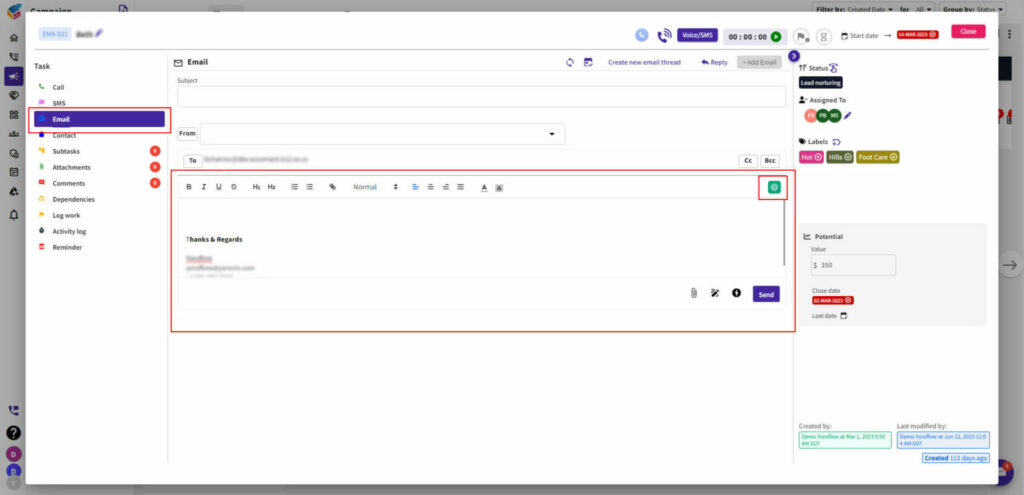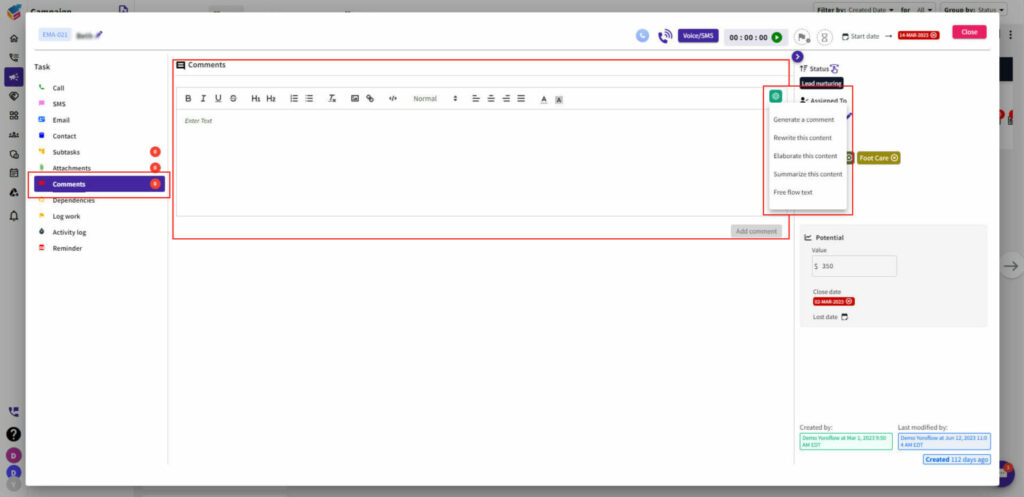Table of Contents
In recent years, the utilization of AI in business communication has witnessed a significant surge, revolutionizing the way individuals interact, collaborate, and communicate. Nearly every organization has embraced AI in some capacity, and collaborative tools have harnessed AI’s power to enhance engagement in the workplace.
AI-powered communication has not only streamlined and simplified work processes but also offers a plethora of capabilities that have the potential to reshape the very foundations of business management.
What is business communication?
Business communication is the exchange of information, ideas, and messages within an organizational context for the purpose of achieving business objectives. It involves the transmission, reception, and interpretation of information between individuals or groups within a business or between different businesses. Effective business communication is essential for promoting collaboration, coordination, decision-making, and the overall success of an organization.
Business communication can take various forms, including verbal (face-to-face conversations, meetings, presentations), written (emails, memos, reports), and digital (instant messaging, video conferencing, social media). It encompasses both internal communication within an organization, such as communication between employees, departments, and management, as well as external communication with clients, customers, suppliers, stakeholders, and the public.
Key elements of effective business communication include clarity, conciseness, accuracy, relevance, and appropriateness. It involves the use of appropriate language, tone, and style based on the audience and purpose of the communication. Good communication skills, including listening, speaking, writing, and nonverbal communication, are crucial for conveying messages effectively and fostering understanding, collaboration, and positive relationships within a business environment.
What is Artificial Intelligence?
AI, or Artificial Intelligence, is the simulation of human intelligence in machines that are programmed to perform tasks that typically require human intelligence. It is a multidisciplinary field of computer science that focuses on creating intelligent machines capable of learning, reasoning, problem-solving, and decision-making.
AI systems are designed to analyze vast amounts of data, recognize patterns, and make predictions or take actions based on that analysis. They can perform tasks that typically require human cognitive abilities, such as natural language processing, speech recognition, visual perception, problem-solving, and even creative tasks.
There are different types of AI, including:
- Narrow AI: Also known as Weak AI, narrow AI is designed to perform specific tasks within a limited domain. Examples include virtual assistants like Siri and Alexa, recommendation systems, and image recognition systems.
- General AI: Also referred to as Strong AI, general AI aims to possess human-like intelligence and can understand, learn, and apply knowledge across various domains. General AI can perform tasks that require intelligence like that of a human.
- Machine Learning: Machine learning is a subset of AI that focuses on algorithms and statistical models that enable machines to learn from data and make predictions or take actions without being explicitly programmed. It allows systems to improve their performance over time as they are exposed to more data.
- Deep Learning: Deep learning is a specialized form of machine learning that uses artificial neural networks with multiple layers to process and analyze complex patterns in data. It has been particularly successful in areas such as image and speech recognition.
Artificial intelligence technologies have wide-ranging applications across various industries, including healthcare, finance, manufacturing, transportation, and many others. They have the potential to automate repetitive tasks, enhance decision-making processes, improve efficiency, and drive innovation.
It is important to note that while AI has advanced significantly, current AI systems are still limited in their ability to exhibit true human-like intelligence and understanding. Ongoing research and development in the field aim to further improve AI capabilities and address ethical and societal implications associated with its use.
The impact of AI in business communication
AI has made a profound impact on business communication, manifesting in the following ways:
- Automation of routine tasks, boosting productivity.
- Enhanced engagement in both internal and external communication.
- Improved customer experiences.
- Facilitated better decision-making through data analysis.
- Reduced potential threats and instances of fraud.
Challenges encountered when using AI in communication
While AI has the potential to revolutionize organizational interactions and make a significant impact, it also presents certain challenges. Some of these challenges include:
- Occasional misleading outcomes from data-driven predictions.
- Increased risks of mishandling sensitive data.
- Difficulty in distinguishing between content generated by humans and AI.
Importance of improving business communication in an organization
Improving business communication in an organization is crucial for several reasons. Here are some key benefits of artificial intelligence and reasons highlighting the importance of enhancing business communication:
- Enhances Collaboration and Teamwork: Effective communication fosters collaboration and teamwork within an organization. Clear and open communication channels enable employees to share ideas, exchange information, and work together towards common goals. It promotes synergy, creativity, and innovation by leveraging diverse perspectives and expertise.
- Facilitates Efficient Decision-Making: Good communication ensures that information flows smoothly and accurately between different levels of the organization. When communication channels are effective, decision-makers have access to the necessary information, enabling them to make informed decisions in a timely manner. This reduces delays, misunderstandings, and errors in decision-making processes.
- Boosts Employee Engagement and Morale: When employees feel that their voices are heard and their ideas are valued, it leads to increased engagement and morale. Transparent and open communication cultivates a positive work environment, fosters trust, and empowers employees. They are more likely to be motivated, productive, and committed to the organization’s success.
- Improves Customer Service and Satisfaction: Effective communication plays a vital role in delivering exceptional AI customer service. Clear and responsive communication with customers helps in understanding their needs, addressing their concerns promptly, and building strong customer relationships. Satisfied customers are more likely to remain loyal and recommend the organization to others.
- Prevents and Resolves Conflicts: Miscommunication or lack of communication can lead to conflicts within an organization. By improving business communication, misunderstandings can be minimized, and conflicts can be resolved more effectively. Clear expectations, open dialogue, and active listening help in preventing conflicts and creating a harmonious work environment.
- Enhances Organizational Alignment: Effective communication ensures that all employees are aligned with the organization’s mission, goals, and values. It helps in cascading information throughout the organization, ensuring everyone understands the strategic direction and their role in achieving organizational objectives. This alignment promotes a sense of unity and common purpose.
- Strengthens External Relationships: Business communication extends beyond the organization’s boundaries. Effective communication with external stakeholders such as clients, suppliers, partners, and investors are vital for building and maintaining strong relationships. It helps in understanding their needs, negotiating contracts, resolving issues, and establishing a positive reputation in the marketplace.
- Drives Organizational Growth and Success: Ultimately, improving business communication contributes to the overall growth and success of the organization. It improves operational efficiency, reduces errors, enhances customer satisfaction, and fosters a positive work culture. Clear and effective communication enables the organization to adapt to changes, seize opportunities, and stay ahead in a competitive business landscape.
Leveraging AI features in your daily workflow with Yoroflow
Yoroflow, a prominent provider of business process automation software, has seamlessly integrated OpenAI’s state-of-the-art technology using a secret key to enhance its capabilities in managing emails, comments, and documents. By harnessing the power of ChatGPT integration, Yoroflow users can now experience more intelligent and efficient communication and collaboration.
Email Response: The integration of Email Response empowers Yoroflow users to compose emails with enhanced ease and precision. OpenAI’s language model offers intelligent and contextually relevant suggestions, enabling users to effortlessly craft replies, rewrites, elaborations, and summaries of professional and personalized email content. This integration not only saves time but also improves productivity and ensures that email conversations are more engaging and effective.

Comment: Yoroflow’s Comment feature has also received a significant boost through the integration with OpenAI. Users now can provide detailed and insightful comments on documents, spreadsheets, and tasks. OpenAI’s language model assists in generating clear and constructive feedback, thereby enhancing collaboration among team members and facilitating faster iterations on projects.

Documents: Moreover, Yoroflow’s Documents feature has been elevated through the integration of OpenAI. This integration offers users powerful capabilities in document generation and automation. OpenAI’s language model aids in automatically generating accurate and coherent content for various document types, such as contracts, proposals, and reports. This integration not only saves time but also ensures the consistency and quality of the generated documents.

By incorporating OpenAI’s advanced technology, Yoroflow has elevated its email, comment, and document management capabilities to unprecedented levels. Users can now leverage the power of artificial intelligence app to streamline their communication, collaboration, and document creation processes, ultimately driving productivity and achieving better business outcomes.
The future of AI in business communication
Despite the challenges and associated risks, the potential of artificial intelligence in business is too significant to overlook. Organizations will continue to embrace data-driven processes, utilizing insights to approach problems strategically. Virtual assistants and chatbots will become even more adept at connecting with people 24/7, resolving common issues in a natural and nuanced manner.
The true potential of AI tools is yet to be fully realized, and we are only beginning to uncover its possibilities.




